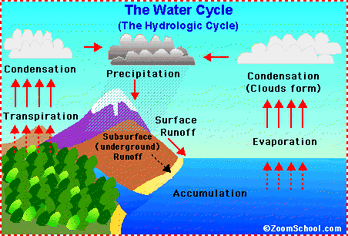(Created page with "==thumb|348px The water cycle, also known as the hydro logic cycle or the H₂O cycle, describes the continuous movement of water on, above and below ...") |
(tHE) |
||
| (One intermediate revision by one other user not shown) | |||
| Line 1: | Line 1: | ||
| − | + | [[File:Watercycle.gif|thumb|348px]] |
|
| − | The water cycle, also known as the hydro logic cycle or the H₂O cycle, describes the continuous movement of water on, above and below the surface of the Earth. |
+ | The water cycle, also known as the hydro logic cycle or the H₂O cycle, describes the continuous movement of water on, above and below the surface of the Earth. |
| + | == The Cycle== |
||
| ⚫ | = |
||
| + | |||
| ⚫ | <span style="font-size:17px;line-height:22px;">The mass water on Earth remains fairly constant over time but the partitioning of the water into the major reservoirs of ice, fresh water, saline water and </span>[http://en.wikipedia.org/wiki/Atmosphere atmospheric water]<span style="font-size:17px;line-height:22px;"> is variable depending on a wide range of </span>[http://en.wikipedia.org/wiki/Climate_change climatic variables]<span style="font-size:17px;line-height:22px;">. The water moves from one reservoir to another, such as from river to ocean, or from the ocean to the atmosphere, by the physical processes of </span>[http://en.wikipedia.org/wiki/Evaporation evaporation]<span style="font-size:17px;line-height:22px;">, </span>[http://en.wikipedia.org/wiki/Condensation condensation]<span style="font-size:17px;line-height:22px;">, </span>[http://en.wikipedia.org/wiki/Precipitation_%28meteorology%29 precipitation]<span style="font-size:17px;line-height:22px;">, </span>[http://en.wikipedia.org/wiki/Infiltration_%28hydrology%29 infiltration]<span style="font-size:17px;line-height:22px;">, runoff, and subsurface flow. In so doing, the water goes through different phases: liquid, solid ice, and gas vapor</span> |
||
| + | [[Category:Nature]] |
||
| + | [[Category:Natural]] |
||
| + | [[Category:Water]] |
||
| + | [[Category:Article stubs]] |
||
| + | [[Category:Article]] |
||
Latest revision as of 16:35, 5 April 2014

The water cycle, also known as the hydro logic cycle or the H₂O cycle, describes the continuous movement of water on, above and below the surface of the Earth.
The Cycle[]
The mass water on Earth remains fairly constant over time but the partitioning of the water into the major reservoirs of ice, fresh water, saline water and atmospheric water is variable depending on a wide range of climatic variables. The water moves from one reservoir to another, such as from river to ocean, or from the ocean to the atmosphere, by the physical processes of evaporation, condensation, precipitation, infiltration, runoff, and subsurface flow. In so doing, the water goes through different phases: liquid, solid ice, and gas vapor